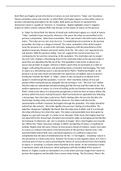Both Plath and Hughes present the theme of nature as cruel and harsh in ‘Tulips’ and ‘Snowdrop’.
Nature symbolises solace and serenity, to which Plath and Hughes oppose as they utilise nature to
present a threatening atmosphere for the reader. Both poets use flowers to represent the
destruction nature is capable of. However, in ‘Snowdrop’, Hughes highlights nature’s negative
impact on others around, whereas Plath only focuses on the impact of nature on the persona.
In ‘Tulips’ by Sylvia Plath, the themes of death and confinement appear as a result of nature.
‘Tulips’ symbolise hope and purity, whereas in this poem the tulips are personified as the
persona’s perpetrator, rather than consolation. This is perceived in the sixth stanza where it
states, ‘The tulips are too red…they hurt me.’ A complaining tone is present as the persona
personifies the tulips as a danger to herself. The colour symbolism of the white hospital
room the persona is in, as well as the red tulips, juxtaposes with the peacefulness of the
speakers temporary freedom and harsh reality of her life. The colour ‘red’ represents love
and passion. With the persona stating, ‘too red’, suggests she cannot access love; it is
overbearing for her and too consuming. In the quotation, ‘The vivid tulips eat my oxygen’
the verb ‘eats’ displays a threatening tone for the inanimate tulips as the persona makes it
seem they are absorbing the life out of her. This quotation is also ironic as plants are a
source and provider of oxygen, whereas in Plath’s poem they are portrayed as a taker of
oxygen, suffocating the persona, and presenting nature as harmful and damaging. This view
of nature as a threatening source is also presented in Plath’s ‘Wuthering Heights’ as the
persona is at war with nature and describes her experience as fatalistic and as if nature is
inviting her towards her death. In ‘Tulips’, nature is also conveyed as an illusion in the
speaker’s mind through the quotation, ‘rust-red’. ‘Red’ resembles notions of love and
passion which eventually decays alongside the red turning to ‘rust’. The verb ‘rust’ implies
that the tulips are abandoned and deteriorating just like the love and life inside of her. The
positive appearance of nature, as a form of healing, purity and freedom become distorted in
Plath’s mind as she takes on a destructive perspective on how the form of nature affects the
persona within the poem. During this poem, Plath had endured an appendectomy following
a miscarriage. Here the tulips could mirror Plath’s feelings after the loss she felt after the
miscarriage; feeling empty and abandoned. However, the tulips could also be the
representation of Plath’s husband Ted Hughes through the quotation, ‘The tulips should be
behind bars like animals,’ this simile signifies the persona’s feeling of vulnerability. The
adjective ‘dangerous’ highlights the threat that the tulips pose to Plath, and it is as though
the tulips will devour her when they open. The tulips could potentially have been given by
Hughes as a get well soon gift. In a letter to her therapist, Plath wrote that Hughes beat her
two days before the miscarriage, therefore perceiving the tulips as damaging and hurtful like
her husband. Furthermore, the ‘red’ is symbolic of danger- this is what Hughes was towards
her. Where the ‘Tulips’ now pose a danger to Plath’s perspective of nature, corrupting her
outlook, Hughes does the same. Known to have posed a threat of violence, nature now takes
its course as a violent instrument in the deterioration of the personas mental state. Critic
Jeannine Dobbs states Plath ‘uses a personal experience as a setting to express the
complexities that the idea of childlessness has for her.’ In Ted Hughes’, ‘Snowdrop’ nature is
also perceived as a destructive force, however he focuses on the negative impact of it from a
universal point of view as well as presenting the theme of survival derived from the brutality
of nature. A ‘snowdrop’ is a flower which flourishes in the winter. As the snowdrop is white
it represents purity and innocence, which juxtaposes with the hardship of the season it
blooms in. Hughes creates an atmosphere of a cruel winter and uses images from nature to
portray the toughness and brutality that a severe winter brings. The first stanza ‘Now is the




